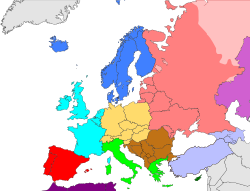Southeast Europe


Southeast Europe or Southeastern Europe is a geographical region of Europe, consisting primarily of the Balkan peninsula. Sovereign states that are generally included in southeastern Europe are, in alphabetical order, Albania, Bosnia and Herzegovina, Bulgaria, Croatia, Cyprus, Greece, Kosovo[a], Macedonia, Moldova, Montenegro, Romania, Serbia, Slovenia and Turkey.
These boundaries can vary greatly due to political, economic, historical, cultural, and geographic considerations of the observer and as such are widely disputed.
Definition
The first known use of the term "Southeast Europe" was by Austrian researcher Johann Georg von Hahn (1811–1869) as a broader term than the traditional "Balkans".[1]
Balkans model

This concept is based on the boundaries of the Balkan peninsula. The countries that have been described as being entirely within the region are: Albania, Kosovo,[2] Bosnia and Herzegovina, Bulgaria, Macedonia and Montenegro.[3]
Countries that are, at least partially, described to be within the region are: Croatia, Greece, Italy, Romania, Serbia, Slovenia and Turkey.[4]
States in southeast Europe
 Albania
Albania Bosnia and Herzegovina
Bosnia and Herzegovina Bulgaria
Bulgaria Croatia[5][6][7]
Croatia[5][6][7] Cyprus
Cyprus Greece
Greece Kosovo[a]
Kosovo[a] Macedonia
Macedonia Moldova
Moldova Montenegro
Montenegro Romania
Romania Serbia
Serbia Slovenia
Slovenia
- Regions within other states
East Thrace, Turkey – the area immediately north of the Bosphorus, constituting approximately three per cent of Turkey's land area. East Thrace comprises Edirne Province, Kırklareli Province, Tekirdağ Province, and part of Istanbul Province.
Stability Pact for South Eastern Europe model
The Stability Pact for South Eastern Europe was an institution aimed at strengthening peace, democracy, human rights and economy in the countries of South Eastern Europe from 1999 to 2008. It was replaced by the Regional Cooperation Council (RCC) in February 2008. The RCC replaced the Stability Pact, which was driven more by outside partners such as the EU, the US, Japan and Turkey, and the countries included were: Albania, Bosnia and Herzegovina, Bulgaria, Croatia, Macedonia, Moldova, Montenegro, Romania, and Serbia.
South East Europe Transnational Cooperation Program
The South East Europe (SEE) program is a program set up within the framework of the Regional Policy's Territorial Cooperation Objective of the European Union in order to improve integration and competitiveness in the area. It had 235,6 million euro of funding available from 2007-2013.[8]
See also
- Percentages agreement
- Regional Cooperation Council
- South East Europe Media Organisation
- Southeast European Cooperative Initiative
- South-East European Cooperation Process
- Southeast European Times
- Stability Pact for South Eastern Europe
Notes
References
- ^ Hösch, Nehring, Sundhaussen (Hrsg.), Lexikon zur Geschichte Südosteuropas, S. 663, ISBN 3-8252-8270-8
- ^ Template:Kosovo-note
- ^ Istituto Geografico De Agostini, L'Enciclopedia Geografica – Vol.I – Italia, 2004, Ed. De Agostini p.78
- ^ Jelavich, Barbara (1983). History of the Balkans: Eighteenth and nineteenth centuries. Cambridge University Press. p. 1. ISBN 978-0-521-27458-6.
{{cite book}}: Cite has empty unknown parameter:|coauthors=(help) - ^ "Borders in Central Europe: From Conflict to Cooperation". Geopolitics of European Union Enlargement: The Fortress Empire. Routledge. 2007. p. 165. ISBN 978-1-134-30132-4.
{{cite book}}: Unknown parameter|authors=ignored (help) - ^ Andrew Geddes,Charles Lees,Andrew Taylor : "The European Union and South East Europe: The Dynamics of Europeanization and multilevel goverance", 2013, Routledge
- ^ Klaus Liebscher, Josef Christl, Peter Mooslechner, Doris Ritzberger-Grünwald : "European Economic Integration and South-East Europe: Challenges and Prospects", 2005, Edward Elgar Publishing Limited
- ^ www.southeast-europe.net/en

